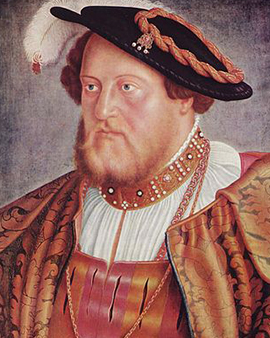


Do you remember the head of a man from the Renaissance, which once adorned the 50-Mark note of the Federal Republic of Germany with a determined look? This was a detail of the portrait of Hans Urmiller painted by Barthel Beham, one of the most remarkable German artists of the 16th century. Together with his young son, the man still stands before us today, very much alive and tastefully dressed - and can be admired in the Städel in Frankfurt.
Already at a young age, the Nuremberg artist Barthel Beham distinguished himself as the creator of strikingly masterful copperplate engravings. He is a much younger contemporary of Albrecht Dürer, and his expressive portraits of patricians and noble rulers are also influenced by him. Beham was in productive competition with the great master, but was more rebellious than the latter. He joined the radical reformers around Thomas Müntzer and followed their social-revolutionary slogans, only to be banished from the city in disgrace. Beham went to Munich and from then on he dedicated his skills to the rulers: He became court painter to the humanistically minded Duke of Bavaria, who supported him extensively. Finely dressed ladies and gentlemen of the Munich patriciate preferred to have their portraits painted by this Nuremberg master: The women showed themselves with their splendid bonnets, furs and chains, sometimes even with their pets, like the famous woman with parrot. Among the men, the thoughtful, almost psychologizing look is particularly striking. The painted or engraved portraits were intended to preserve the memory of these personalities even after their death, this was a typical thought during the Renaissance. Thus the important Bavarian politician Leonhard von Eck was portrayed both in the painting and in the high-circulation copperplate engraving by Barthel Beham. The master created works that were intended to please humanistically educated art collectors. On one of these enigmatic panel paintings we see a naked young woman who - still unnoticed - is already embraced by death. Nothing is more transient than the beauty of youth, which is drastically underlined by the body of a woman in a shroud behind her. A Memento Mori of a disturbing nature!
When Emperor Charles V and his brother Ferdinand stayed in Munich, they too became aware of the master's arts and had their portraits painted by him. Duke Wilhelm IV still had a lot in store for his promising young court painter, so he sent him to Italy, where he was to further perfect his art. But there Beham was struck by a serious illness, which he died of at the age of 38. Had he lived longer, we might perhaps have called him Grien in the same breath as Dürer or Hans Baldung, but instead he has remained an unfortunately relatively unknown genius to this day, a genius to be discovered.

Do you remember the head of a man from the Renaissance, which once adorned the 50-Mark note of the Federal Republic of Germany with a determined look? This was a detail of the portrait of Hans Urmiller painted by Barthel Beham, one of the most remarkable German artists of the 16th century. Together with his young son, the man still stands before us today, very much alive and tastefully dressed - and can be admired in the Städel in Frankfurt.
Already at a young age, the Nuremberg artist Barthel Beham distinguished himself as the creator of strikingly masterful copperplate engravings. He is a much younger contemporary of Albrecht Dürer, and his expressive portraits of patricians and noble rulers are also influenced by him. Beham was in productive competition with the great master, but was more rebellious than the latter. He joined the radical reformers around Thomas Müntzer and followed their social-revolutionary slogans, only to be banished from the city in disgrace. Beham went to Munich and from then on he dedicated his skills to the rulers: He became court painter to the humanistically minded Duke of Bavaria, who supported him extensively. Finely dressed ladies and gentlemen of the Munich patriciate preferred to have their portraits painted by this Nuremberg master: The women showed themselves with their splendid bonnets, furs and chains, sometimes even with their pets, like the famous woman with parrot. Among the men, the thoughtful, almost psychologizing look is particularly striking. The painted or engraved portraits were intended to preserve the memory of these personalities even after their death, this was a typical thought during the Renaissance. Thus the important Bavarian politician Leonhard von Eck was portrayed both in the painting and in the high-circulation copperplate engraving by Barthel Beham. The master created works that were intended to please humanistically educated art collectors. On one of these enigmatic panel paintings we see a naked young woman who - still unnoticed - is already embraced by death. Nothing is more transient than the beauty of youth, which is drastically underlined by the body of a woman in a shroud behind her. A Memento Mori of a disturbing nature!
When Emperor Charles V and his brother Ferdinand stayed in Munich, they too became aware of the master's arts and had their portraits painted by him. Duke Wilhelm IV still had a lot in store for his promising young court painter, so he sent him to Italy, where he was to further perfect his art. But there Beham was struck by a serious illness, which he died of at the age of 38. Had he lived longer, we might perhaps have called him Grien in the same breath as Dürer or Hans Baldung, but instead he has remained an unfortunately relatively unknown genius to this day, a genius to be discovered.
Page 1 / 2








